‘Nothing prepared me’: These rare, ‘wretched beauties’ will break your heart
By Anabel Dean
The bear sighs. Sounds human.
She’s invisible in a steel cage, a shadowy mound curled into herself, concealing the glorious lemon crescent of moon emblazoned on her chest.
Unthinkably, she’s been incarcerated for 24 years, until two days ago, when she was rescued from a bear bile farm and delivered to a sanctuary in the lush foothills of the Tam Dao mountain range in Northern Vietnam.
Now she is sheltered under a corrugated iron roof in a quarantine shed where a veterinary surgeon is whispering words of comfort through the bars, like a god of small things, working a miracle.
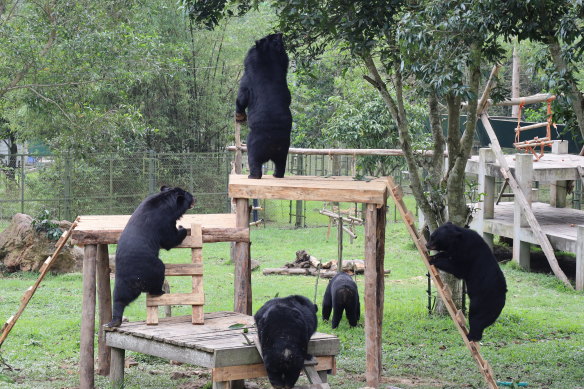
Safe houses- bears at the Tam Dao sanctuary in Vietnam.
The bear twitches her muzzle and unfurls her paw. She has a penchant for chopped pumpkin and an endearing playfulness with the hammock. It is as if a star shell bursts. Can there be a more joyous declaration of life than an endangered animal that survives decades of indescribable cruelty and then, seemingly, forgives it?
The moon bear has a name. It is QQ.
I’ve longed for this encounter as a bear sponsor at Sydney’s Taronga Park Zoo but this is not a zoo. Tam Dao Sanctuary doesn’t provide nature on a plate for entertainment. Animals Asia is a charity that grants limited access to visitors who want to help bring a species back from the brink of extinction while ending bear bile farming in Vietnam.
Taking bears from the wild for bear bile farming has been illegal in Vietnam since 2005 (when there were thought to be around 4000 bears in captivity). There are still at least 300 bears kept in cages not bigger than a garden shed through a legal loophole that allows farmers to keep existing animals if they claim not to be extracting bile.
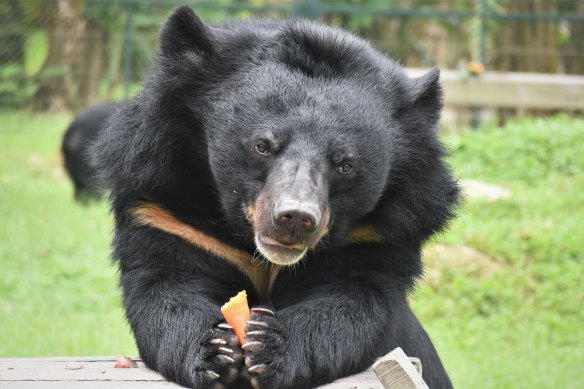
Tam Dao is Animals Asia’s second bear sanctuary, with the first in China.
Nobody believes a bear is kept in a cage for anything other than bile extraction, least of all Jill Robinson, the British founder of Animals Asia and the world’s leading expert on bear bile farming. She’s my guide today, having flown from Hong Kong to Vietnam for the opening of a second sanctuary, at nearby Bach Ma.
I have driven for a little over an hour by car from Hanoi (following an itinerary devised by Adventure World Travel) from chaotic city streets into the realm of mist and water and earth latticed together by brute force and raw labour. The tableau of rice paddies specked by buffalo and farmers in conical hats is just the backdrop to the bear refuge cupped in an amphitheatre at Tam Dao National Park.
A security officer waves me through the gate to find Robinson. She’s a blonde-haired eco-warrior waiting in a bamboo glade that’s thrumming with the soft rhythmic croaking of frogs. She steps forwards, yellow butterflies spooling about her ankles, and promptly begins to recount her first experience of bear bile farming in China in 1993.
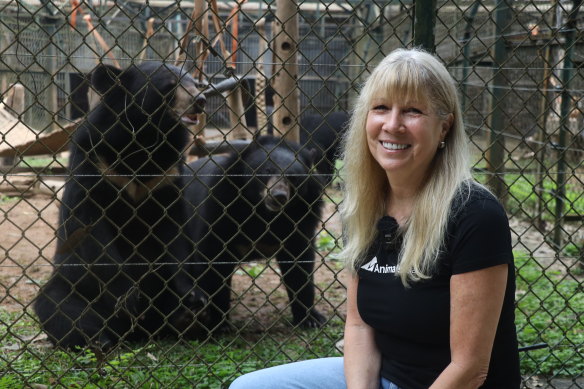
Animals Asia founder Jill Robinson with Mudky and Star.
“Absolutely nothing prepared me for that moment,” she confides.
A group of bears had been corralled in a circular pit and were standing on their back legs teased by tourists dangling apples on strings near hungry mouths. Robinson snuck away, into a basement, where she found 32 moon bears in shocking condition peering out of “crush cages” that enabled bile to be drained through catheters inserted into their gallbladders.
“They were making nervous popping sounds as if anticipating something terrible was about to happen,” she remembers. “Then, suddenly, I felt something touch my shoulder. I spun around to see a female moon bear reaching her paw through the cage.
“At that moment, it seemed simply right to take her mighty paw in my hand and, rather than hurting me as I know now that she could have done, she squeezed my fingers and held my eyes with hers.”
Robinson never saw Hong again. The message was clear. She had to do something, so she established Animals Asia in 1998 to oversee the construction of sanctuaries in China and Vietnam. To date, nearly 700 farmed bears have been rescued and, hearteningly, there’s now an agreement with the Vietnamese government to end the practice completely by 2026.
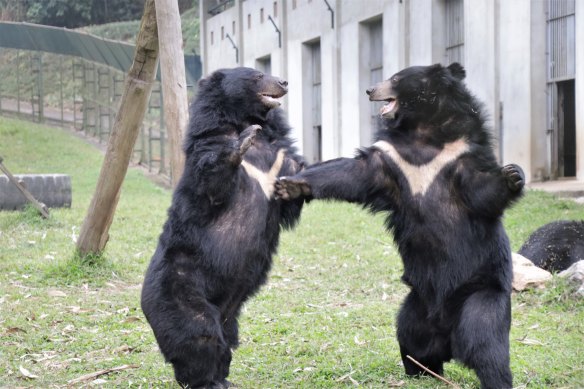
At the sanctuary, bears begin their lives all over again.
QQ is the newest resident in an oasis for 199 Asiatic black bears, both moon and sun bears, living out their lives in grassy enclosures peppered with pools, trees, tripods, tunnels and swings. The structures are designed to stimulate natural behaviour and aid rehabilitation for the legacy of torture – arthritis, heart disease, missing and broken limbs, fear and anxiety – but none of these wretched beauties can be returned to the wild. They will need intensive care for the rest of their lives.
There has been a long tradition of bear bile extraction from the moon bear (found as far west as Afghanistan and as far north as Siberia) and the smaller sun bear (one of the world’s rarest bears living in the hot equatorial lowland forest of Asia). Bear bile isn’t like rhino horn or tiger penis, which have no proven benefit to human health, but it’s been used for millennia as traditional medicine for a range of conditions from muscle aches and hangovers to cancer and liver disease.
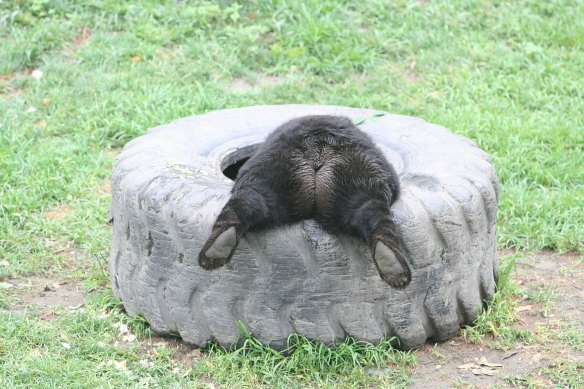
Both moon and sun bears live in grassy enclosures peppered with pools, trees, tripods, tunnels and swings.
Liquid gold comes in a tiny bottle that sells illegally all over Vietnam but bears don’t need to be farmed because there are effective synthetic alternatives.
It’s enrichment hour at the sanctuary where bears are beginning their lives over again. Two gladiators pause in mock combat to unearth obstacles smeared with plum sauce. Some root out vegetables scattered in searchable nooks and crannies while others are toying with foliage, wallowing in ponds, communing in yoga classes. One is lost in a vortex of agitation, pacing back and forth over a beaten track of grass.
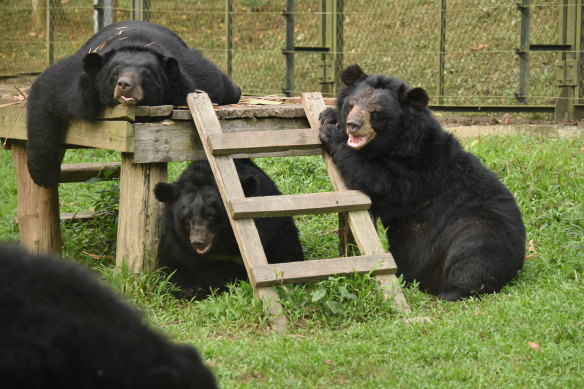
Structures are designed to stimulate natural behaviour and aid rehabilitation for the legacy of torture.
“Let me show you something,” says Robinson, heading down a winding pathway to the hospital. We slip into sterile clothes and foot covers. She pulls back the huge metallic door to reveal a shaggy inpatient. “Hello, Barli, you beautiful old boof,” she says.
Barli and I lock eyes through bars. “Oh, I know you,” he seems to say. His paw, the size of a baseball mitt, twiddles with a coconut. He’s recovering from surgery and keeps picking open the wound from his gall bladder operation. His healing is complicated due to a chronic itching skin condition that the veterinary team have been treating for years, but he cannot be stitched up forever, and the staff are preparing for the worst.
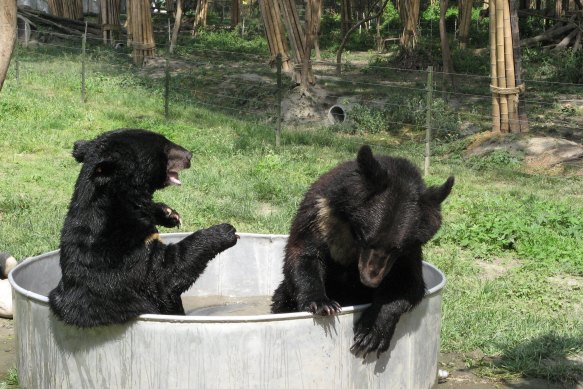
The bears will need intensive care for the rest of their lives.
The feeling of dread is justified. Barli is euthanised a few days after we meet. “He broke many hearts,” Robinson tells me later. “He was the gentlest of bears but bile farming broke him and he wasn’t ever going to leave that wound alone. This is our reality. It hurts.”
Staff are offered counselling with every bear that must go to rest, finally, in the graveyard. It’s the last place that I visit before leaving. In a peaceful corner, beneath a wild mountain, headstones are marked by photographs and words. There is such kindness in humanity here. Every bear is loved. Mourned and remembered.
Every bear has a name.
DETAILS
TOUR
The Tam Dao bear sanctuary experience by Animals Asia is exclusive to Adventure World in their 13-day Authentic Vietnam itinerary from $4335 a person. See adventureworld.com; animalsasia.org
STAY
Hanoi’s Sofitel Legend Metropole is an irresistible blend of old-world charm next to the old French quarter and the Opera House. Rooms from $465 a night. See sofitel-legend-metropole-hanoi.com
EAT
Hanoi’s KOTO Van Mieu Restaurant – (an acronym) Know One, Teach One – gives at-risk and disadvantaged youth the opportunity to break the poverty cycle by forging a better future for themselves, their families and their communities. See koto.com.au
The writer was a guest of Adventure World.
Sign up for the Traveller Deals newsletter
Get exclusive travel deals delivered straight to your inbox. Sign up now.